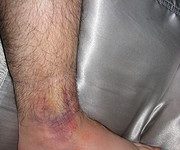Teen EMT is an occasional series documenting the experiences of high school senior and SciJourn reporter KiOntey Turner as she works with patients on real ambulance calls in St. Louis.
Leaving Saint Louis University Hospital in our ambulance after a pretty mild call, we were dispatched to treat two patients having allergic reactions. Dealing with two patients is not something normally done on an ambulance that only has one stretcher, but we were committed and had to do the job that we were assigned.
When we got to the scene there was a nurse standing outside of the clinic. She looked worried, frustrated, and concerned—all at the same time.
“What were the patients exposed to?” we asked. She wasn’t quite sure, but they both had been decontaminated—a way to cleanse people of any substance that may cause harm to the body. We could come in to the clinic, examine the patients and transport them to the hospital, the nurse informed us.
We went directly into the room where the patients were held, and immediately I saw that both men had hives and a very flushed appearance.
I didn’t know what to expect, but I did all that I could do for these men until we got to the hospital. We took their blood pressure and kept them calm and collected. Neither of the men spoke English very well and talking to them was a challenge, but it had to be done.
When we got them to the hospital, the staff at Barnes Jewish Hospital was much more concerned about the contamination issue. The nurses decontaminated both patients again to make sure that they were all clean.
Neither the medics nor myself knew what substance caused the allergic reaction, but after looking at the MSDS (Material Safety Data Sheet)—a form that explains the allergic reactions, severe reactions and other effects that the said chemical could have on the human body—we came to the conclusion that we were exposed to potassium sulfate (K2SO4).
Potassium sulfate is described as a non-flammable skin irritant, when the skin is exposed for a certain period of time. This chemical can also have negative effects on two specific body systems, the respiratory and integumentary system. The respiratory system controls each person’s breathing, and exchange of oxygen and carbon dioxide throughout the body. The integumentary system is the skin, which regulates body temperature and also is the first line of defense when fighting off any illness. When someone is exposed to potassium sulfate, the skin gets irritated. Hives and rashes can form and cause that person to itch severely. If the respiratory system is also exposed to this chemical, the throat can swell shut in order to protect itself.
| Related story: Emergency Medicine from a Teen's View |
Treating these patients was hard work and a risk for the medics. While treating these men, the medic crew and myself each came in slight contact with potassium sulfate, which resulted in all of us experiencing a minor itching feeling on our hands and face. We informed the nursing staff at Barnes Hospital and we were told to head back to headquarters, remove all of our clothes, rinse off in cool water, and then use soap and water to clean our bodies. Our clothes were immediately washed clean and we were back out on the streets. Kionty Turner

This work is licensed under a Creative Commons Attribution-NonCommercial-NoDerivs 3.0 Unported License









Great articlts. I think its cool that you get to experience actual things like that. :yes :good
i have now learned what potassium sulfate does. i really like this article. its a good opportunity for you to experience this while your in high school. i wished my high school had this.:-)